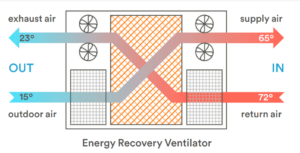Report Background
To keep our living spaces safe and healthy, the City of New York sets minimum ventilation requirements for all residential buildings. Ventilation is needed to remove pollutants and moisture from apartments—especially from kitchens and bathrooms—and to provide occupants with fresh, clean air. Proper ventilation improves indoor air quality, enhances comfort, and helps prevent mold growth, which improves the durability of building components and reduces the risk of respiratory illnesses, like asthma. Unfortunately, many NYC residential buildings fall short of delivering these benefits.
Common Ventilation System Problems
Inspections of large residential buildings in NYC have found ventilation problems in well over 50% of inspected buildings. Many are under-ventilated and suffer from stale, stuffy, or humid air. Others are drastically imbalanced, with some floors of the building receiving little to no airflow while other floors experience over-ventilation, uncomfortable drafts, and whistling winds. Ventilation is a holistic, whole-building system, which means that failure of one component—such as a broken fan or clogged bathroom vent—can affect proper functioning across the entire system.
Inspections often uncover the following problems:
- Fans are broken, switched off, or not tuned to the proper speed settings.
- Ducts are dirty, clogged, damaged, or leak air.
- Vents (registers) are leaky, clogged, poorly tuned, or blocked by furnishings.
- Air pressure fluctuates with changes in wind, weather, and season.
Getting to Know Your Ventilation System
Most large multifamily buildings in New York City have centralized, exhaust-based ventilation systems. Old, pre-war buildings often have no mechanical systems at all. Some buildings rely on windows and other natural ventilation strategies instead. Some newer buildings have balanced systems that pair exhaust with an equal amount of fresh, filtered supply air.
This report will cover the following ventilation system types:
- No Mechanical Ventilation
- Exhaust-Only Ventilation
- Balanced Ventilation

Example of a balanced centralized system vs. a decentralized system. Centralized systems serve the entire building, with mechanical units typically located on the roof. Decentralized or unitized systems serve specific areas of the building, typically on a floor-by-floor or unit-by-unit basis.
Solutions for Better Ventilation Systems
There are a number of proven practices that can enhance the performance of your ventilation system. These range from basic maintenance measures to comprehensive system upgrades. In this report, we provide three recommended scopes of work to increasingly improve ventilation system performance:
- Perform Basic Maintenance (Good) – clean ductwork and exhaust registers and check airflow rates
- Improve Exhaust (Better) – clean ducts and registers and seal gaps that allow air to leak out of the ventilation system
- Provide Balanced Ventilation (Better Yet) – upgrade to a balanced, fresh air ventilation system that includes both exhaust- and supply-side ventilation.

Example of a Energy Recovery Ventilator (ERV). During winter, heat from exhaust air is transferred to supply air in the ERV’s heat recovery core. The system reverses in summer, where heat from the outdoor air is transferred to the exhaust, helping to cool the supply air.
Read the full BE-Ex Better Ventilation playbook to learn more about these ventilation system solutions. Be sure to work with a qualified contractor to determine the solutions best suited for your building. The NYC Accelerator, a free program provided by the City of New York, can also provide technical assistance to get started on ventilation upgrades. The playbook lists additional resources for relevant education, training, financial assistance and incentives.

